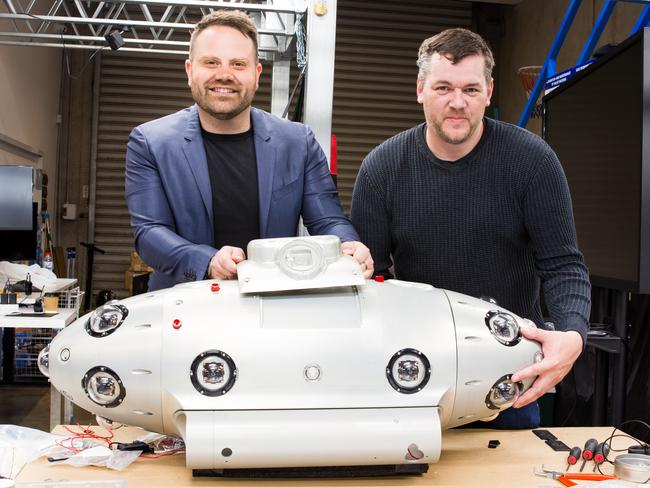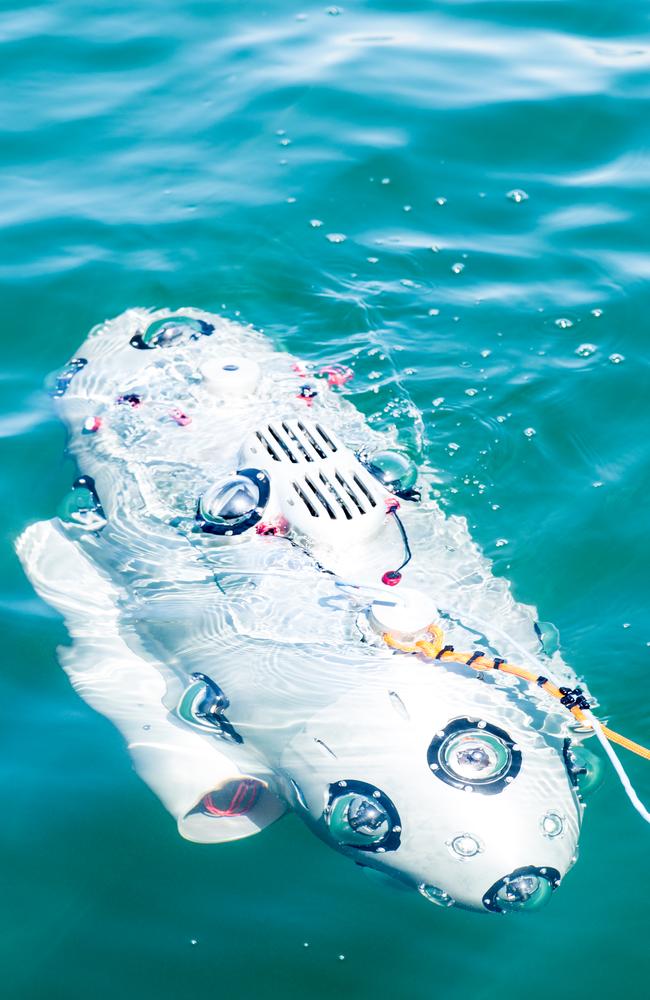Melbourne-based start-up UAM Tec say their new submarine will help find ships and planes lost at sea
New miniature submarine technology from a Melbourne-based start-up unveiled in Sydney could prove a game-changer in the search for ships and planes lost at sea, such as MH370.
Innovation
Don't miss out on the headlines from Innovation. Followed categories will be added to My News.
“If it’s under the water, we plan on being able to find it.”
That’s the promise and business case of Melbourne-based tech start-up, UAM Tec, who unveiled their new small-scale autonomous submarine in Sydney today.
The football-shaped subs, which are 1.2 metres long and weigh about 70kgs, are designed to map and photograph the world’s oceans, lakes and waterways, ultimately building a maritime version of Google Street View which the company has dubbed “WaterView”.

Although some important underwater discoveries have been made in the past few years – including the discoveries of the wrecks of Captain Cook’s ship the Endeavour and the Australian submarine AE1, which sank off the coast of New Guinea in 1914 – those breakthroughs have ironically revealed how little we really know about the world’s oceans.
It took an entire year for an Argentian submarine that sunk in 2017 (with 44 sailors on board) to be located; it took almost two years before the black boxes from the doomed Air France Flight 447 were located. (The flight from Rio to Paris crashed into the Atlantic several hours after takeoff on June 1, 2009. All 228 passengers and crew on board were killed.)
And then of course there’s the greatest maritime mystery of them all: the disappearance of Malaysia Airlines Flight MH370, which is presumed to have crashed somewhere in the Indian Ocean on March 8, 2014, killing all 239 people on board, including six Australians. Although fragments of the aircraft later washed up on the shores of islands off the east coast of Africa, its fuselage and black boxes have never been recovered, despite the most extensive – and expensive – search in aviation history.

UAM Tec’s co-founder Benjamin Fleming said the search for MH370 reinforced the need for better technology to understand the 71 per cent of the Earth’s surface that was under water, only 5 per cent of which had been adequately mapped.
Mr Fleming and his business partner Shawn Taylor told News Corp a “swarm” of their subs would prove very useful in the event of another aeroplane lost at sea, as they would be more easily able to track the location of a pinging black box.
“Search and rescue and recovery has always been at the front of all of our minds,” Mr Fleming said.
While the sub can currently travel 100km and scan down to a depth of 300 metres – too shallow for the expected resting place of MH370 – Mr Fleming said the company was hoping to develop a version that could descend to a depth of 1.2 kilometres within two years.

Powered by lithium batteries that are good for 40 hours, the subs are fitted with 22 cameras and have different sensors to gauge water temperature, pressure and even acidity – useful for tracking environmental changes underwater.
Asked whether the subs could have a role to play in preventing shark attacks (after today’s incident in which two men were bitten by a shark in Airlie Beach, Queensland) a company spokesperson told News Corp that while they were not devised for this purpose, the subs “could be deployed in known hot spots for sharks to capture data on the underwater environment”.
RELATED NEWS:
Failed MH370 search lasted over 1000 days
Evidence mounting MH370 was glided into ocean
New discovery could solve mystery surrounding Amelia Earhart
Greatest mysteries of our oceans uncovered
The new-generation subs had the ability to transform the way humans understood, interacted and protected the planet’s water bodies, Mr Fleming said.
“We want to be able to educate the next generation about everything that exists in our world. The fact that we know more about space than we do about our own oceans is unacceptable with today’s technology.
“Our Sub Mapping technology will change this. Not only will we be able to discover new species of marine life and track climate change, but in time we will also be able to optimise search and rescue operations, locate wreckages and black boxes, and much more,” he said.
Originally published as Melbourne-based start-up UAM Tec say their new submarine will help find ships and planes lost at sea
